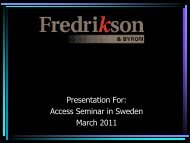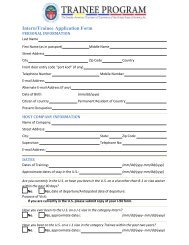ORIENTATION GUIDE FOR SACC-USA TRAINEE PROGRAM
ORIENTATION GUIDE FOR SACC-USA TRAINEE PROGRAM
ORIENTATION GUIDE FOR SACC-USA TRAINEE PROGRAM
Create successful ePaper yourself
Turn your PDF publications into a flip-book with our unique Google optimized e-Paper software.
esources, safety, and culture. One example of this would be Chicago’s Albany Park neighborhood where<br />
a junior high school (6th to 8th grade) has students speaking more than seventeen different languages.<br />
In the U.S. you will likely find that there are generally many more options for items than there are in<br />
Sweden. Occasionally, Swedes can find it overwhelming when they go to the grocery store and are faced<br />
with so many options – especially when you cannot find the brand that you are familiar with in Sweden.<br />
Time is another issue that can be different. For work and meetings, Americans are generally very<br />
punctual. For dinner parties at someone’s home, casual parties, and meeting friends out at a bar;<br />
Americans rarely show up at the exact time that had been discussed. It is usually acceptable to be<br />
around 15 minutes late to dinner and 15 minutes to an hour late to casual parties or meeting friends at<br />
a bar. Additionally, public transportation, especially in larger cities, rarely runs according to schedule. It<br />
may save you a headache if you look at time intervals for a bus, instead of exact times, and do not<br />
expect it to arrive at your stop at the exact minute listed in the timetable.<br />
Having more options and slightly different concepts of time are just two examples of what might be new<br />
to you when you are in the U.S. You may pick up on other small differences during your stay. Just do not<br />
let yourself get too frustrated with these, in other words, do not sweat the small stuff, enjoy the<br />
experience of life and diversity in the U.S instead.<br />
Housing<br />
There is a fairly substantial variance in housing throughout the U.S. Following are general guidelines<br />
regarding housing in the U.S.:<br />
• Unless otherwise arranged with your host employer, you will need to make housing arrangements<br />
for your arrival.<br />
• In some cases, it may be easier to arrange for temporary housing for the first week, and then use<br />
the first week to locate housing for the remainder of your training period.<br />
• It is important to include security deposits in your budget, which are often equivalent to one or two<br />
months’ rent and generally required when renting an apartment. This is generally returned to you if<br />
there were no damages to the apartment.<br />
• It is recommended to arrange for housing situation that facilitates interactions with Americans and<br />
not only people of your own nationality.<br />
• Set a limit for the rent that you cannot exceed in order to have some money left to enjoy your spare<br />
time.<br />
• Keep in mind that utilities (heat, water, electricity) are often not included in the rent and will be an<br />
additional expense.<br />
• Ask each potential housing provider if utilities are included and what they generally average each<br />
month.<br />
• Keep in mind that there are many advantages to shared housing. Not only will it save you money,<br />
but it will hopefully also introduce you to other people. If you are lucky, moving in with a roommate<br />
or subletting can also mean that the apartment is already furnished. Note that the term<br />
“roommate” normally does not mean that you have to share the same bedroom.<br />
9





